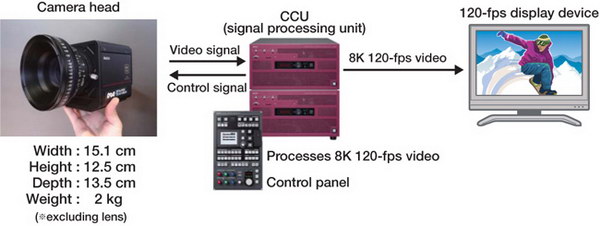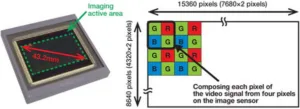At the recent IEEE International Solid-State Circuits Conference (ISSCC) held in San Francisco February 22 – 26, R. Funatsu from NHK Science & Technology Research Laboratories, (STRL) (Tokyo, Japan) and 11 of his colleagues from NHK and Forza Silicon, (Pasadena, CA) presented a paper titled “133Mpixel 60fps CMOS Image Sensor with 32-Column Shared High-Speed Column-Parallel SAR ADCs”. This sensor had also been presented earlier at the NHK STRL Open House May 29 – June 1, 2014. NHK STRL is serious about 8k video – of the 35 exhibits at their open house, 13 of them were related to 8k Super Hi-Vision.
This image sensor was a joint development of NHK and Forza and was part of NHK’s effort to develop 8k video. Previous 8k video cameras had used either 8 Mpixel or 33Mpixel sensors. An 8Mpixel sensor is clearly inadequate for 8k video, which has approximately 33Mpixels in the image. Even a 33 Mpixel sensor isn’t really enough – it will provide one sub-pixel (red, green or blue) for every displayed pixel. A sensor with a Bayer filter on it, as is commonly used for 4k video cameras, needs two sub-pixels per pixel to generate an image, or 66 Mpixels for an 8k sensor.
133 Mpixel 60Hz sensor from NHK and Forza Silicon
This new sensor was designed by Forza Silicon and fabricated using a 0.18 µm 3.3V/1.8V CMOS process with 1D stitching. The sensor takes advantage of Forza Silicon’s Gen 3 readout architecture to achieve frame frequency of 60 fps. The Gen 3 readout architecture uses a pseudo-column parallel design with 14b redundant successive approximation register ADCs to achieve a throughput of 128 Gb/s at full resolution and frame rate.
The 133 Mpixels will provide 4 sub-pixels per displayed pixel, as shown in the image. By oversampling the image, the 133 Mpixel sensor assures there are no spatial artifacts generated in the image, leading to better quality 8k Super Hi-Vision. (Is better 8k video an oxymoron? How good do you have to be?) The ability to do full 60Hz video is important, however, since studies have shown that as the pixel count goes up in a display, the frame rate must also go up to allow the viewer to see the detail. Unfortunately, many 4k video systems have lowered the frame rate from 60Hz to 30Hz or 24Hz, in an effort to control the total size of 4k files and the bit rates associated with the transmission of the 4k content.
“Our continued partnership with Forza Silicon through the years to support NHK has resulted in the success of a number of significant projects such as the development of the 133 MP sensor, and previously the 33 MP Super Hi-Vision image sensor. Forza’s dedicated support and its image sensor design expertise enabled us to achieve the Super Hi-Vision 8k single-chip camera – the largest pixel count of any video image sensor”, said Dr. Hiroshi Shimamoto, senior research engineer at NHK STRL.
At the NHK open house, the sensor and the prototype camera system had been demonstrated. NHK also demonstrated its 33 Mpixel 8k camera system, also based on a Forza-designed sensor. This camera was capable of a 120Hz frame rate with full resolution and bit depth.

NHK 8k 120Hz Camera System with a 33Mpixel sensor from Forza Silicon
Analyst Comment
I hope NHK and Forza are working on a 66 MPixel 120Hz sensor. This will have the same data rate as the 133 MPixel 60 Hz sensor and provide significantly better image quality if there is any motion in the image. And isn’t motion the whole point of video? (MSB)

